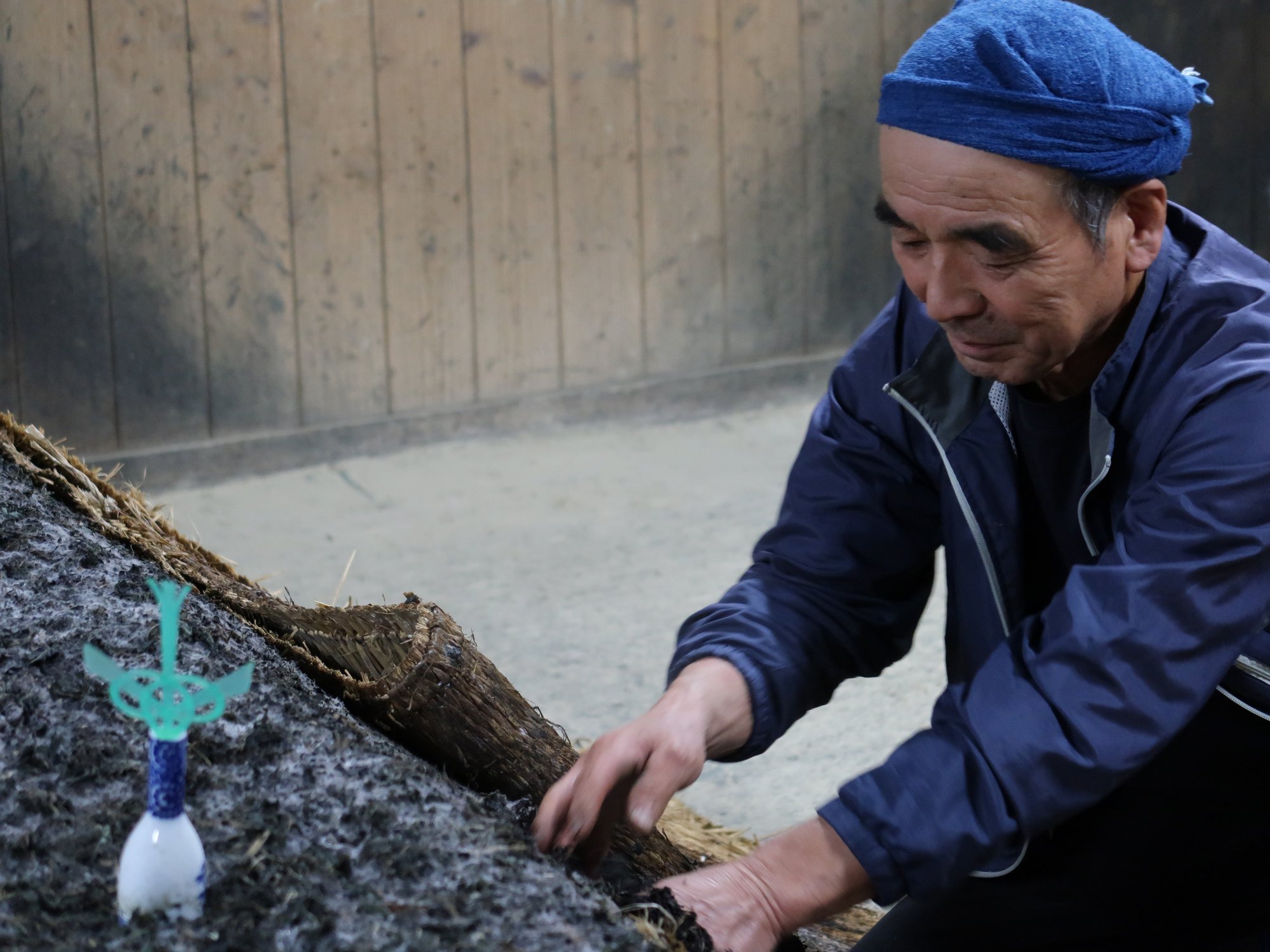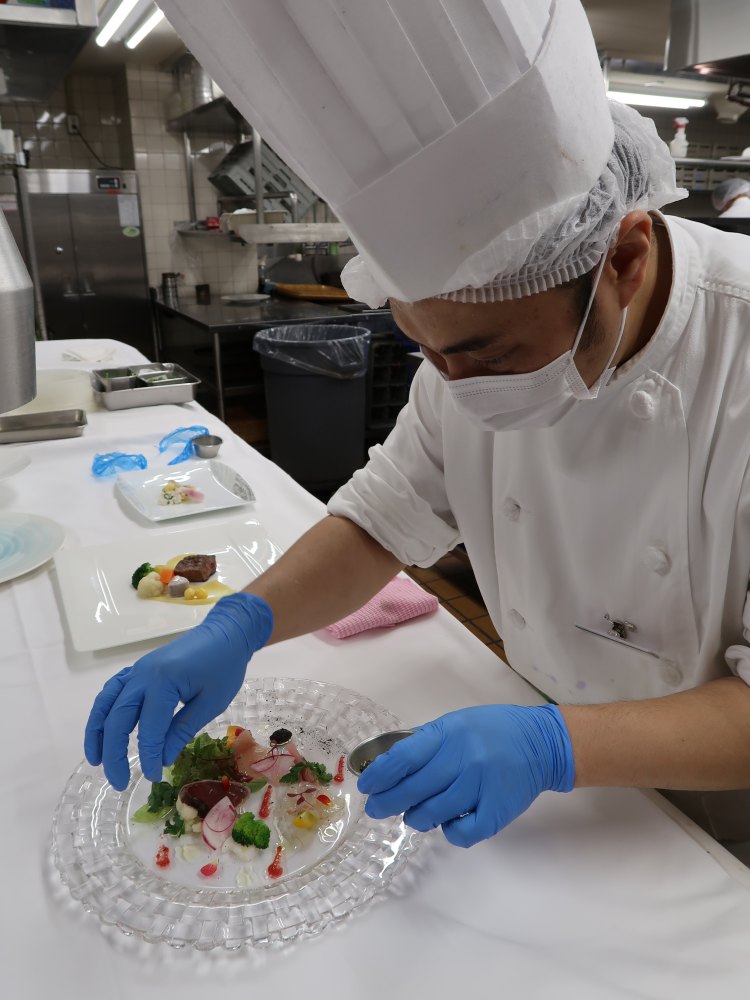
Traditional indigo makers and artisans in Japan are passionate about ensuring their dyeing trade lives on
- Indigo has been around for more than 5,000 years, including 1,300 years in Japan and especially in Tokushima city
- Families that grow indigo and make dye from it continue the legacy, while artisans, artists and even chefs support them
From the tips of his fingers to well above his wrists, Toshiharu Furusho’s skin has taken on the colour of his profession.
For nearly 50 years, Furusho has combined wood ash, lime, yeast, black sugar, and most importantly, the dye from fermented indigo leaves – known as sukumo – in perfect ratios.
Only when he is satisfied that the fermentation process has run its natural course, something that can take up to a month, will he reach for lengths of material or finished clothing and repeatedly dip them into stone tubs of the mixture at his ramshackle factory in the backstreets of Tokushima city, before squeezing and rinsing them out by hand.
As he hangs the clothing up to dry, Furusho nods his head. These are the perfect shade of deep, dark blue that is synonymous with the indigo dying that originated in the Indus Valley around 5,000 years ago, before travelling the Silk Road and reaching Japan in the Nara period, between AD710 and 794.

The colour, known as Awa-Ai, is in many ways emblematic of Japan – the logos for this year’s Tokyo Olympic Games and Paralympics were indigo on white – but the people of this part of Shikoku Island in the country’s south tend to refer to it as Tokushima blue.
“The most attractive part of clothes that are coloured with natural dyes is that the shades change gradually as they are worn, making each piece unique,” says 74-year-old Furusho, a sixth-generation traditional indigo dyer who has been recognised by the national government as an artisan with special intangible cultural skills.
Tai chi granted heritage status by Unesco after years of not making the cut
Tokushima became the centre of indigo dyeing in Japan as indigo plants thrived in fields alongside rivers in eastern Tokushima that were regularly swollen by typhoons or summer storms, bringing nutrient-rich soil from the highlands further inland.
“In centuries gone by, all the indigo dyers in Japan wanted to use Tokushima indigo and there was a decree from the dyers of Hiroshima that they would only use our indigo because it was of such high quality,” Furusho tells the Post.
Prized for its attractive hues, cloth that has been treated with indigo also has antibacterial properties, is considered more comfortable for people with skin allergies and even has a reputation for keeping mosquitoes at bay during the summer months, he says.
I enjoy my work, but I also enjoy seeing the younger generations come in and be interested in this tradition
Inevitably, however, the industry has been challenged by technology, including the introduction of chemical dyes and factories that operate on a vast scale.
Today, Furusho says, he is one of only five traditional indigo dyers still operating in the prefecture. Yet he remains upbeat, as he firmly believes that the best results are still from the ancient, tried-and-tested methods of dyeing. His daughter, Michiko, has been working alongside him for many years and is determined to take over the business and continue the family tradition.
And that is music to the ears of Osamu Nii, the sixth generation of his family to grow indigo plants and ferment the freshly cut material until the sukumo can be extracted approximately four months later. At his farm in the Itano district outside Tokushima City, Nii cultivates about six hectares (14.8 acres) of plants and, despite being 73 years old, has no intention of retiring.

“I enjoy my work, but I also enjoy seeing the younger generations come in and be interested in this tradition,” he says, adding that his son and grandson already work alongside him and will, in time, take on the farm.
“It might look like hard work, but I have been doing this for more than 50 years, so I’m used to it.”
The crop is planted in April, with a first harvest in July and then a second crop gathered in August. The leaves and heavier stems are separated with blowers before the crop is spread on the ground to dry. The dried leaves are gathered and compacted into neat, knee-high stacks, each containing around three tonnes of the crop, in a number of barns.
Covered with straw matting to keep the heat in, the stacks are periodically turned over to encourage the fermentation process and sprinkled with water.
From hanfu designer to hand-painted fan maker, China’s artisan youth
After four months, the sukumo is mixed with wood ash and other ingredients that help create a highly alkaline environment that activates microorganisms and induces the deoxidation that is needed to turn it into deep blue dye.
Nii waves an arm at the fields around his home, a former indigo merchant’s house, and says in 1900 every field would have grown indigo plants.
“This is our family business and I do not want it to die out,” he says. “Dyers need what we produce and we are both an important part of making sure that the culture of indigo dyeing does not disappear. I want to hand that on.”

In an effort to preserve the growing and use of indigo, artisans, artists and even chefs across the prefecture are being encouraged to incorporate the tradition into contemporary projects.
Hitoshi Doi studied jewellery making under a master craftsman in Florence before returning to Tokushima five years ago and opening his own studio, where he uses ground seashells that are dyed with indigo and formed into unique shapes for his designs.
“It is difficult to put into words why this blue is so special and makes such wonderful jewellery, but I love that it is completely natural and comes from sustainable sources,” he said.

Not far away, Rumi Ohno has opened an atelier that takes in kimonos – often very old items that have been handed down through generations of a family, yet rarely worn – and gives them a new lease of life.
The rich fabrics readily absorb indigo dye, leaving only the gold and silver thread unaffected and giving an item of clothing a completely new look.
Other kimonos are carefully cut and turned into a range of stylish modern dresses, coats or hats. Smaller offcuts can be transformed into bags, purses or glasses cases, or incorporated into pieces of furniture.
Artist Tokiko Kajimoto moved to Tokushima, her husband’s hometown, 30 years ago and was thrilled to work with indigo that had been grown and processed locally, using it in a range of her contemporary designs and artworks.

“What attracts me the most, even today, is the power of indigo as a natural material from which very special dyes can be created,” she says “It is very simple, but the colours it creates are very attractive to the eye. And it is not only in Japan that it is appreciated; I think it has appeal all over the world.”
She does worry, however, about the future of this iconic Japanese colour.
“I am really quite concerned for the producers of the dyes because what they do is essential to people like me,” she says. “There are many people all over Japan who want to use these dyes, but there are so few people actually making them.
“I think we should be safe for the next generation of dye producers, but I am not sure about the generation after that.”
If the tradition were to die out it would be tragic, Kajimoto says, as she senses a broad upswing of interest in art, clothing, design and cuisine that draw on centuries of knowledge of indigo.

“In the past, indigo clothing was more frequently worn by older people, but now I see more interest among younger people as well, a new generation who like it,” she said. “There is a growing awareness that indigo is a sustainable crop and the products are eco-friendly, and that appeals to young people, even if it is a little more expensive.”
Another promising area for indigo is in adventurous culinary dishes, with Naomichi Kimoto working the ingredient into dishes at the AoAwo Naruto Resort Hotel, from starters and soups to antipasti, grilled sea bream caught in the Naruto Strait in front of the property, and desserts ranging from indigo-flecked sorbet to pumpkin and indigo pudding.
“The hotel recently invited a number of artists and designers to give some of the rooms an indigo theme and we really wanted to expand that idea into the dinners that we serve as well,” says Kimoto.

Used in some Asian societies as a medicine, indigo is rich in nutrients and contains natural fibre, even when it is ground finely to be incorporated into many of Kimoto’s dishes. Slightly bitter to the taste, it works particularly well with ayu (sweetfish), but is also sufficiently versatile to add flavour – and colour – elsewhere, he says.
“Of all the ways I’ve tried to prepare indigo in a dish, I think that it is paired best with the seafood that this part of Shikoku is famous for,” he adds.

